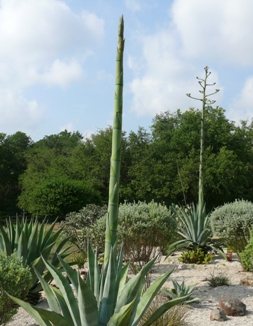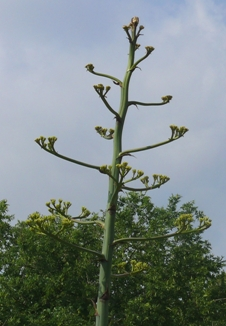Author: Bill Ward
Steve Lowe, Kendall County Park Naturalist, wrote to say that this spring he has seen more than the usual number of Agave species blooming. He suggests May is a good month to reiterate the attributes of this landscape plant that does so well in Hill Country yards. The following paragraphs are written by Steve.
While the month of April is florally linked to the emergence of the Easter lily, May could welcome another lily flowering, those of Agave (maguey in Spanish).

Along with Yucca, these dominant landscape specimens are sometimes referred to as “woody lilies” and are botanically kin to true lilies. However, to most of us, agaves look more like succulent cactus or artichokes on steroids.
One other common name for maguey is “Century Plant,” referring to its latent flower habit. Because they are monocarpic, flowering only once in their life, it may seem like a 100-year event. Most species require no more than 8 to 10 years to mature and send up a mast-like flower scape. For some reason, perhaps our recent drought, I have noticed more blooming this spring than ever.
Agave is native from our Southwest through Mexico and Central America. Over 200 species are known, ranging in size from 10- to 12-foot giants to dwarfs easily kept in pots. Most are easily grown in sunny, xeric conditions with good drainage.
In Texas only 4 or 5 species are thought to be native, but magueys have been valued and transplanted by man prior to historic cultivation. Young plants form basal shoots and can be broken off and easily transplanted. Carbon dating has suggested maguey processing for food, drink, and fiber by Pre-Columbian settlements in Sonora and Arizona.

Prior to colonizing Mexico’s Central Valley, the Aztecs consumed both “aquamiel” (“honeywater”) and the fermented version, pulque. Later, the Spanish refined the process to produce mescal and tequila. All of these beverages are extracts from the terminal leaf bud. Of greater economic importance, fiber from the leaves, sisal, was found to make the finest rope known before synthetics. Agave sissalana was exported to East Africa and the Philippines to expand its cultivation base in the 1800s.
Agaves make fine landscape subjects, keeping some design basics in mind:
1. Scale and placement: Most species will grow to considerable size and are armed with potentially dangerous spines. Place them away from high traffic areas, removed from pets and children. Spines can be clipped with stout pruners.
2. Cold tolerance: Select landscape species that tolerate Hill Country winters, or plan to shelter tender subjects in pots.
Plants suitable for landscapes: Agave americana (several varieties), A. bracteosa, A. filifera, A. harvardiana, A. lechuguilla, A. lophantha, A. neomexicana, A. ochahui, A. parryi (several varieties), A. salmiana, A. scabra, A. schidigera, A. striata, A. victoria-reginae, and A. weberi.
Useful as container subjects: A. attenuate, A. bracteosa, A. demettiana, A. geminiflora, A. ocahui, A. parrasana, A. schidigera, and A. victoria-reginae.
